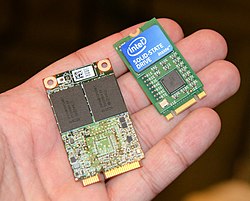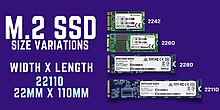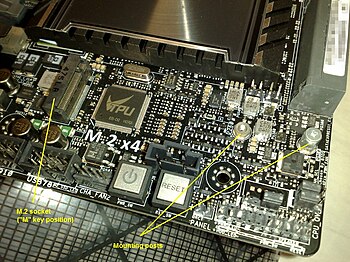Type a search term to find related articles by LIMS subject matter experts gathered from the most trusted and dynamic collaboration tools in the laboratory informatics industry.
 An M.2 2280 solid-state drive (SSD), 22 mm wide and 80 mm long | |
| Connects to | Motherboard via one of:
|
|---|---|
| Common manufacturers | Intel Phison Realtek Samsung Silicon Motion SK Hynix |
| Design firm | PCI-SIG |
| Introduced | November 1, 2013 |
| Dimensions |
|

M.2, pronounced m dot two[1] and formerly known as the Next Generation Form Factor (NGFF), is a specification for internally mounted computer expansion cards and associated connectors. M.2 replaces the Mini SATA (mSATA) standard and the Mini PCIe (mPCIe) standard (which is how it got the short name of M dot 2 from being Mini SATA 2). Employing a more flexible physical specification, M.2 allows different module widths and lengths, which, paired with the availability of more advanced interfacing features, makes M.2 more suitable than mSATA in general for solid-state storage applications, particularly in smaller devices such as ultrabooks and tablets.[2][3][4]
Computer bus interfaces provided through the M.2 connector are PCI Express x4 (up to four lanes), Serial ATA 3.0, and USB 3.0 (a single logical port for each of the latter two). It is up to the manufacturer of the M.2 host or module to select which interfaces are to be supported, depending on the desired level of host support and the module type. Different M.2 connector keying notches denote various purposes and capabilities of both the M.2 hosts and modules, and also prevent the M.2 modules from being inserted into incompatible host connectors.[2][3][5]
The M.2 specification supports NVM Express (NVMe) as the logical device interface for M.2 PCI Express SSDs, in addition to supporting legacy Advanced Host Controller Interface (AHCI) at the logical interface level. While the support for AHCI ensures software-level backward compatibility with legacy SATA devices and legacy operating systems, NVM Express is designed to fully utilize the capability of high-speed PCI Express storage devices to perform many I/O operations in parallel.[2]: 14 [6]

M.2 modules can integrate multiple functions, including the following device classes: Wi-Fi, Bluetooth, satellite navigation, near field communication (NFC), digital radio, WiGig, wireless WAN (WWAN), and solid-state drives (SSDs).[7] The SATA revision 3.2 specification, in its gold revision as of August 2013, standardizes M.2 as a new format for storage devices and specifies its hardware layout.[2]: 12 [8] Buses exposed through the M.2 connector include PCI Express (PCIe) 3.0 and newer, Serial ATA (SATA) 3.0 and USB 3.0; all these standards are backward compatible.
The M.2 specification provides up to four PCI Express lanes and one logical SATA 3.0 (6 Gbit/s) port, and exposes them through the same connector so both PCI Express and SATA storage devices may exist in the form of M.2 modules. Exposed PCI Express lanes provide a pure PCI Express connection between the host and storage device, with no additional layers of bus abstraction.[9] PCI-SIG M.2 specification, in its revision 1.0 as of December 2013, provides detailed M.2 specifications.[2]: 12 [10]
Three options are available for the logical device interfaces and command sets used for interfacing with M.2 storage devices, which may be used depending on the type of M.2 storage device and available operating system support:[2]: 14 [6][9]



The M.2 standard is based on the mSATA standard, which uses the existing PCI Express Mini Card (Mini PCIe) form factor and connector. M.2 adds the possibility of larger printed circuit boards (PCBs), allowing longer modules and double-sided component population. Consequently, M.2 SSD modules can provide double the storage capacity within the footprint of an mSATA device.[2]: 20, 22–23 [4][13]
M.2 modules are rectangular, with an edge connector on one side and a semicircular mounting hole at the center of the opposite edge. The edge connector has 75 positions with up to 67 pins, employing a 0.5 mm pitch and offsetting the pins on opposing sides of the PCB from each other. Each pin on the connector is rated for up to 50 V and 0.5 A, while the connector itself is specified to endure 60 mating cycles.[14]: 6 However, many M.2 slots (Socket 1, 2 and 3) found on motherboards only provide up to 3.3 V power.[15][16][17]
The M.2 standard allows module widths of 12, 16, 22 and 30 mm, and lengths of 16, 26, 30, 38, 42, 60, 80 and 110 mm. Initial line-up of the commercially available M.2 expansion cards is 22 mm wide, with varying lengths of 30, 42, 60, 80 and 110 mm.[3][5][14][18] The codes for the M.2 module sizes contain both the width and length of a particular module; for example, "2242" as a module code means that the module is 22 mm wide and 42 mm long, while "2280" denotes a module 22 mm wide and 80 mm long.
An M.2 module is installed into a mating connector provided by the host's circuit board, and a single mounting screw secures the module into place. Components may be mounted on either side of the module, with the actual module type limiting how thick the components can be; the maximum allowable thickness of components is 1.5 mm per side, and the thickness of the PCB is 0.8 mm ± 10%.[10] Different host-side connectors are used for single- and double-sided M.2 modules, providing different amounts of space between the M.2 expansion card and the host's PCB.[4][5][14] Circuit boards on the hosts are usually designed to accept multiple lengths of M.2 modules, which means that the sockets capable of accepting longer M.2 modules usually also accept shorter ones by providing different positions for the mounting screw.[19][20]
| Key ID |
Notched pins |
Provided interfaces | Dimensions | Uses |
|---|---|---|---|---|
| A (Socket 1) | 8–15 | 2 of PCIe ×1, USB 2.0, I2C and DP ×4 | 1630, 2230, 3030 | Wi-Fi, WWAN, GPS, Bluetooth, NFC |
| B (Socket 2) | 12–19 | SATA, PCIe ×2, USB 2.0 and 3.0, audio, UIM, HSIC, SSIC, I2C and SMBus | 2230, 2242, 2260, 2280, 22100 | SSD |
| C | 16–23 | Reserved for future use | ||
| D | 20–27 | |||
| E (Socket 1) | 24–31 | 2 of PCIe ×1, USB 2.0, I2C, SDIO, UART, PCM and CNVi | 1630, 2230, 3030 | Wi-Fi, WWAN, GPS, Bluetooth, NFC |
| A+E (Socket 1) | 8–15 and 24–31 | 2 of PCIe ×1, USB 2.0 and CNVi | 1630, 2230, 3030 | Wi-Fi, WWAN, GPS, Bluetooth, NFC |
| F | 28–35 | Future Memory Interface (FMI) | ||
| G | 39–46 | Reserved for custom use (unused in the M.2 specification) | ||
| H | 43–50 | Reserved for future use | ||
| J | 47–54 | |||
| K | 51–58 | |||
| L | 55–62 | |||
| M (Socket 3) | 59–66 | SATA, PCIe ×4, and SMBus | 2230, 2242, 2260, 2280, 22100 | SSD |
| B+M (Socket 2) | 12-19 and 59–66 | SATA, PCIe ×2, and SMBus | 2230, 2242, 2260, 2280, 22100 | SSD |
| Type ID |
Top side |
Bottom side |
|---|---|---|
| S1 | 1.20 mm | — |
| S2 | 1.35 mm | — |
| S3 | 1.50 mm | — |
| D1 | 1.20 mm | 1.35 mm |
| D2 | 1.35 mm | 1.35 mm |
| D3 | 1.50 mm | 1.35 mm |
| D4 | 1.50 mm | 0.70 mm |
| D5 | 1.50 mm | 1.50 mm |

The PCB of an M.2 module provides a 75-position edge connector; depending on the type of module, certain pin positions are removed to present one or more keying notches. Host-side M.2 connectors (sockets) may populate one or more mating key positions, determining the type of modules accepted by the host; as of April 2014, host-side connectors are available with only one mating key position populated (either B or M).[5][14][11] Furthermore, M.2 sockets keyed for SATA or two PCI Express lanes (PCIe ×2) are referred to as "socket 2 configuration" or "socket 2", while the sockets keyed for four PCI Express lanes (PCIe ×4) are referred to as "socket 3 configuration" or "socket 3".[2]: 15 [24]
For example, M.2 modules with two notches in B and M positions use up to two PCI Express lanes and provide broader compatibility at the same time, while the M.2 modules with only one notch in the M position use up to four PCI Express lanes; both examples may also provide SATA storage devices. Similar keying applies to M.2 modules that utilize provided USB 3.0 connectivity.[5][11][25]
Various types of M.2 modules are denoted using the "WWLL-HH-K-K" or "WWLL-HH-K" naming schemes, in which "WW" and "LL" specify the module width and length in millimeters, respectively. The "HH" part specifies, in an encoded form, whether a module is single- or double-sided, and the maximum allowed thickness of mounted components; possible values are listed in the right table above. Module keying is specified by the "K-K" part, in an encoded form using the key IDs from the left table above; it can also be specified as "K" only, if a module has only one keying notch.[5][14]
Beside socketed modules, the M.2 standard also includes the option for having permanently soldered single-sided modules.[14]
In 2017, Samsung introduced a new form factor called Next Generation Small Form Factor (NGSFF), also known as NF1 or M.3, which may replace U.2 in server applications.[26] The NGSFF connector is electrically and dimensionally compatible with M.2 (revision 1.1)'s connector; new functionality is achieved through previously unused (N/C) pins.[27] The main changes compared to M.2 are:
In 2018, the PCI-SIG issued a warning that NGSFF's new pin usage clashes with the pin usage in the upcoming 1.2 revision of the M.2 standard. The new revision uses some of the previously non-connected (N/C) pins to deliver 1.8 V power and USB 2.0 data on the "M" socket. Samsung has sought to standardize its NGSFF/NF1 through JEDEC, but the process appears to have stalled.[29]
JEDEC JESD233 is another specification called Crossover Flash Memory (XFM) for XFM Embedded and Removable Memory Devices (XFMD). It targets to replace the M.2 form factor with a significantly smaller one (also called XT2), so that it can also be designed as an alternative to soldered memory. XFM Express utilizes a NVMe logical interface over a PCI Express physical interface.[30][31]